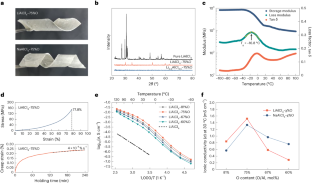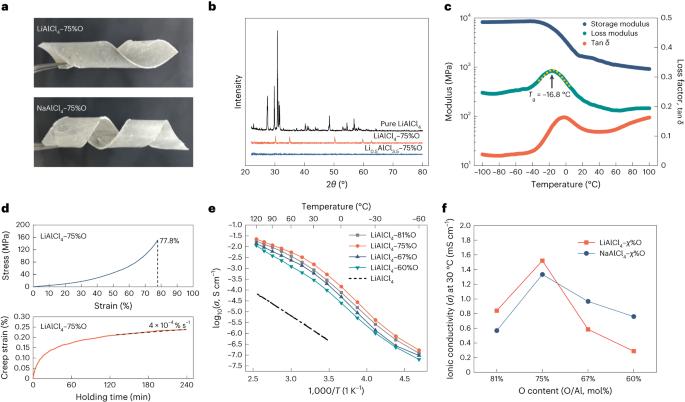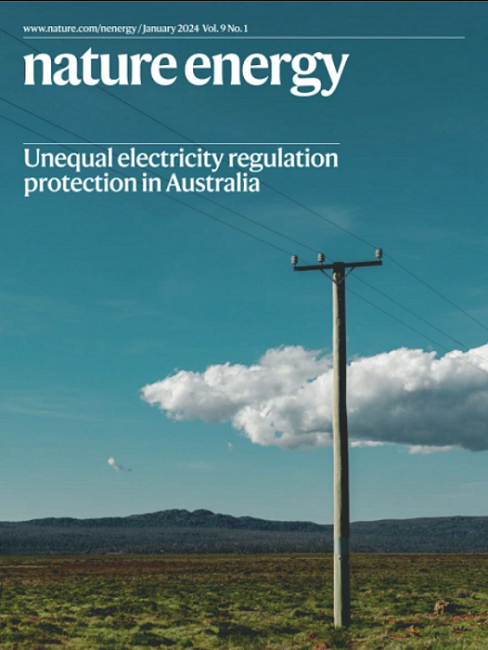具有聚合物粘弹性的无机玻璃电解质
IF 60.1
1区 材料科学
Q1 ENERGY & FUELS
引用次数: 0
摘要
固态电池为电动汽车提供了另一种前景广阔的动力源。然而,无机电解质的界面机械稳定性不如有机电解质。通常需要很高的叠加压力(几兆帕到几百兆帕)才能保持与电极的亲密接触。在此,我们报告了一类粘弹性无机玻璃(VIGLAS),只需用氧取代四氯铝酸盐中的氯即可用作固体电解质。VIGLAS 对 Li+ 和 Na+ 都具有高离子电导率(30 °C 时约为 1 mS cm-1),与 4.3 V 阴极具有出色的化学机械兼容性,并且能够实现无压(<0.1 MPa)锂基和镍基固态电池。低熔化温度(160 °C)使电解质能够有效渗入电极材料,类似于液态电池。此外,电解质的可变形性还有助于通过轧制工艺生产薄膜,实现规模化生产。固态电解质是开发固态电池的核心,而固态电池是一种前景广阔的存储技术。胡永胜及其同事报告了一类具有无机晶体电解质和有机聚合物电解质优点的粘弹性无机玻璃,并展示了无压锂基和镍基固态电池。本文章由计算机程序翻译,如有差异,请以英文原文为准。


Inorganic glass electrolytes with polymer-like viscoelasticity
Solid-state batteries offer an alternative promising power source for electric vehicles. However, the interfacial mechanical stability of inorganic electrolytes is inferior to that of organic electrolytes. A high stack pressure (several to hundreds of megapascals) is often required to maintain intimate contact with electrodes. Here we report a class of viscoelastic inorganic glass (VIGLAS) to serve as solid electrolytes by simply replacing chlorine of tetrachloroaluminates with oxygen. The VIGLAS possesses high ionic conductivity (~1 mS cm−1 at 30 °C) for both Li+ and Na+, superior chemo-mechanical compatibility with 4.3 V cathodes and the ability to enable pressure-less Li- and Na-based solid-state batteries (<0.1 MPa). The low melting temperature (<160 °C) allows the electrolytes to efficiently infiltrate electrode materials, akin to a liquid battery. Additionally, the deformability of the electrolytes facilitates the feasibility of scale-up through the production of thin films via a rolling process. Solid-state electrolytes lie at the heart of the development of solid-state batteries that offer a promising storage technology. Yong-Sheng Hu and colleagues report a class of viscoelastic inorganic glass featuring merits of both inorganic crystalline electrolytes and organic polymer electrolytes and demonstrate pressure-less Li- and Na-based solid-state batteries.
求助全文
通过发布文献求助,成功后即可免费获取论文全文。
去求助
来源期刊

Nature Energy
Energy-Energy Engineering and Power Technology
CiteScore
75.10
自引率
1.10%
发文量
193
期刊介绍:
Nature Energy is a monthly, online-only journal committed to showcasing the most impactful research on energy, covering everything from its generation and distribution to the societal implications of energy technologies and policies.
With a focus on exploring all facets of the ongoing energy discourse, Nature Energy delves into topics such as energy generation, storage, distribution, management, and the societal impacts of energy technologies and policies. Emphasizing studies that push the boundaries of knowledge and contribute to the development of next-generation solutions, the journal serves as a platform for the exchange of ideas among stakeholders at the forefront of the energy sector.
Maintaining the hallmark standards of the Nature brand, Nature Energy boasts a dedicated team of professional editors, a rigorous peer-review process, meticulous copy-editing and production, rapid publication times, and editorial independence.
In addition to original research articles, Nature Energy also publishes a range of content types, including Comments, Perspectives, Reviews, News & Views, Features, and Correspondence, covering a diverse array of disciplines relevant to the field of energy.
 求助内容:
求助内容: 应助结果提醒方式:
应助结果提醒方式:


